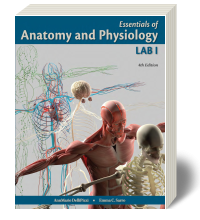Essentials of Anatomy and Physiology Lab I
Fourth Edition DelliPizzi, Sarro, © 2024, 347 pages
This textbook is suitable for an anatomy and physiology lab.
Request Examination Copy Test Drive LAB BookPrices and ISBNs
This title is available in the following formats.
|
Product
Description ISBN |
Description | ISBN | Bookstore (Net Price) |
Student (Retail Price) |
|
LAB BOOKPlus
Online eBook + Lab978-1-5178-1625-4 |
Online eBook + Lab | 978-1-5178-1625-4 (9781517816254) | $42 | $61 |
|
TEXTBOOKPlus
Loose Leaf + eBook + Lab 978-1-5178-1624-7 |
Loose Leaf + eBook + Lab | 978-1-5178-1624-7 (9781517816247) | $66 | $97 |
Description
In addition to introducing general lab procedures, such as safety and using a compound microscope, early labs also cover the important regional and directional terminology of the human body. Students are then introduced to the building blocks of molecules through a molecular modeling lab and learn the basic movements of substances across a membrane by completing labs directed at diffusion and osmosis, ending with an experiment that examines tonicity in red blood cells. Following these basic introductory labs, the students then learn to distinguish between the four major kinds of tissues found in the human body through large labs focusing on microscopic work. The major organ systems that are covered in the first half of Essentials of Anatomy and Physiology Lab I are the Integumentary, Skeletal, Muscular and Nervous systems. Specifically, the Essentials lab manual contains labs that focus on the anatomy of the Integumentary and both the Axial and Appendicular regions of the skeletal system. Finally, both the muscular and nervous systems are divided into two separate labs that concentrate on the anatomy and physiology of each system. The muscular anatomy lab enables students to learn both the structure of a muscle fiber as well as the anatomical locations and structure of skeletal muscles through a clay modeling exercise, where the students mold each muscle on a skeletal base. The muscular physiology lab utilizes the iWorx© human physiology teaching kit to measure EMGs in antagonistic muscle pairs. Similarly, the nervous system anatomy lab utilizes both human brain models as well as a sheep brain dissection. Using the iWorx human physiology teaching kit again, students are able to study neural physiology by measuring auditory and visual reflex response times.
In This Edition
In the fourth edition of Essentials of Anatomy and Physiology Lab I, check your comprehension questions have been added throughout each chapter. Chapter review questions have been revised.

